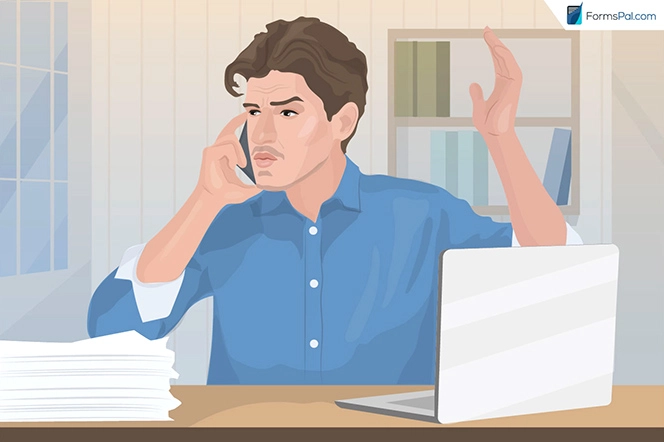Cease and Desist Letter Template
A cease and desist letter is designed to warn its recipient about possible legal action if they do not stop a harmful or unwelcome activity. The letter is usually the last warning before the injured person takes legal action. Therefore, if the recipient ignores the letter and continues their actions, they should be ready to appear in court.
Anyone whose legal rights have been violated can write a cease and desist letter and send it to the offending party. However, it’s recommended to consult the state law and attorney on whether there are reasonable grounds for your letter. If you are sure about the violation, then you should immediately warn the offender about legal consequences. Our template, along with the step-by-step guidelines and free cease and desist letter sample, will make sure that your warning is powerful.
Build Your Document
Answer a few simple questions to make your document in minutes
Save and Print
Save progress and finish on any device, download and print anytime
Sign and Use
Your valid, lawyer-approved document is ready
When to Send a Cease and Desist Letter
A cease and desist letter can come in handy whenever someone harms you or your rights. The words “cease” and “desist” stand for “stop” and “refrain.” Thus, the letter allows its sender to stop unwelcome behavior and prevent it in the future. Cease and desist letters can be helpful in various situations, from copyright infringement to breach of contract. We have prepared the most popular cases, where you should write a cease and desist letter.
Intellectual Property Rights Infringement
A copyright cease and desist letter can be used to notify the recipient about patent, copyright, or trademark infringement. Before writing and sending such a letter, you have to be sure of two things—first, whether your intellectual rights are well-protected, and second, whether you have enough grounds to claim infringement of them. The first thing means that you have to prove your intellectual property rights.
When sending a trademark cease and desist letter, it’s easy to do since trademarks and patents are usually registered with the United States Patent and Trademark Office (USPTO). When it comes to copyright infringement, you will have to try harder (if you haven’t registered your copyright, of course). The copyright belongs initially to its creator, but it’s necessary to prove that you’ve created the original work (for example, with a copyright notice). After proving your legal rights, you are also expected to provide a detailed description of collected proof that confirms copyright or trademark infringement.
Defamation
According to the legal definition (U.S. Code §4101), defamation is an action for libel, slander, or similar proceedings that present any person in a false light or result in dishonor, condemnation, or criticism of any person. Thus, it can cause serious harm to an individual or business. Defamation can be verbal, also known as slander, and written, also known as libel.
If you’ve become a witness of slander or libel, you should immediately send a cease and desist letter to the offending party. As with the trademark or copyright infringement, you will have to send a cease and desist letter with proof of defamation, for example, screenshots or audio materials. You may also need to request the offending party not only to respond to the letter but also to rebut distorted information.
Debt Collection Agency Harassment
A cease and desist letter can serve as a good means to stop the harassment of debt collectors. The Fair Debt Collection Practices Act (§806) states that a debt collector may not harass, oppress, or abuse any person connected with the debt collection. Therefore, if debt collectors continue to harass or threaten you with violence, you may ask a collection agency to stop all the communication with you and warn about possible penalties in case they continue doing so.
The debt collectors cease and desist letter is useful if the debt is not yours. It can also come in handy if you owe the debt, but the statute of limitations (maximum amount of time collectors have to initiate a lawsuit) has expired. Of course, the letter does not release you from the debt, but it prevents unwanted phone calls and harassment.
How to Use a Cease and Desist Letter
If you’ve suffered from harassment, confidentiality violation, or other illegal behavior of another individual or business, it’s natural that you want to provide legal proceedings. However, it can be better to avoid a lawsuit and settle things without addressing the law. Cease and desist letters are a good way to do that. If you decide to use the letter, you are recommended to follow the next steps.
Step 1. Collect the evidence

You are expected to justify your claims with relevant information and evidence. Depending on circumstances, you should add proof of harassment, infringing intellectual property rights, or defamation. For example, you can include screenshots, video, or audio materials. It will leave no room for the offending party to deny the responsibility.
Step 2. Write the letter

The next move is to include all collected information and proofs in your letter. It’s important to use an appropriate letter format. Your tone should be serious and firm, especially when it comes to the warning part. Not everybody may be aware that a cease and desist letter serves as the last warning to stop an unwelcome behavior before going to court. That’s why it’s necessary to emphasize and make the warning clear for the recipient.
Step 3. Send your letter

After preparing your letter, you should send it to the offending party. It’s highly recommended to use certified or registered mail with the return receipt. That’s how you will have the record of the delivered document and use it to prove that the individual has received but ignored the letter.
Step 4. Wait for the response

You should wait a certain period of time after sending the letter. It’s possible to specify the deadline, but since a cease and desist letter is not a legally binding document, the recipient may not respond in time. Nonetheless, the other party has to send a response to a cease and desist letter in one way or another if they do not want a lawsuit.
Step 5. Negotiate or go to court

If the other party responds to your letter and complies with your demand, you can negotiate the damage compensation and settle everything without court involvement. If they do not reply to your letter and continue unwelcome action, you should provide legal proceedings. In this case, a court or government agency can issue a temporary or permanent order prohibiting certain activities.
Filling Out the Cease and Desist Letter Template
After collecting all of the necessary information, it’s time to write your document. You are encouraged to download our template and use our free cease and desist letter example for inspiration. To make your letter well-structured, please, follow the next steps.
Step 1. Indicate the letter type
At the beginning of the document, you should clearly indicate the cease and desist letter type—whether it’s defamation cease and desist letter, copyright infringement, or stop harassment cease and desist letter.
Step 2. Identify the sender
The next move is to name the person and/or company sending the letter. Here, you should identify the sender’s name and address, as well as state the date the document is being sent.
Step 3. Define the harmful or infringing activities
You should describe the infringing activity that affects you or your business. It’s important to provide a detailed description and proof of the violated rights. You may decide to prepare it without an attorney. Still, it’s recommended to consult the attorney and your state law to understand your rights and allegations’ scope.
Step 4. Explain the consequences
It’s important to warn about what will happen if the offender does not stop the aforementioned activities. Usually, if the recipient continues the behavior, the injured party immediately takes legal action against them.
Step 5. Provide the deadline
It’s recommended to provide the deadline for the response. You can also request a written assurance to stop the aforementioned behavior. Note that the recipient may not answer your claim in time, but the deadline will make your document stricter.
Step 6. Sign the letter
The last thing to do is to sign the letter. The signature may be hand-written for the hard copy of the letter and electronic for email. As we said earlier, it’s recommended to send the letter via certified mail to get the return receipt.
Frequently Asked Questions
Is a Cease and Desist Letter Legally Enforceable?
A cease and desist letter is not legally enforceable, but it’s an official letter and should be taken seriously. It’s a formal document that warns about possible legal actions but gives a possibility to settle things down without court involvement. However, if the recipient ignores the letter, the sender may file a lawsuit and get a cease and desist order.
What Is a Cease and Desist Order?
If the recipient of the cease and desist letter fails to comply with its requirements, the injured party has no other alternative but to use the law and address the court. A court or government agency can issue a cease and desist order. While a cease and desist letter serves as a warning notice to an individual or business, a cease and desist order must be complied with. A cease and desist order can be issued temporarily or permanently.
Cease and Desist Letter Sample
Cease and Desist Demand to Stop a Specific Activity
From: John Smith
Company A, LLC
15 Business Str.
Stamford, CT 06905
January 21, 2021
To: Chris Douglas
15 Fine Str.
Stamford, CT 06905
Re: Cease and Desist Demand to Stop a Specific Activity
I am writing on behalf of my organization regarding your illegal Activity. You are hereby notified to immediately cease and desist any further Activity relating to my business and me.
You are also requested to return within 10 business days the signed written assurance affirming that you will cease and refrain from any further Activity. You will not receive another warning.
If you do not respond to this cease and desist notice and continue the Activity, we will have to pursue legal action against you.
Sincerely,
John Smith
(signature)